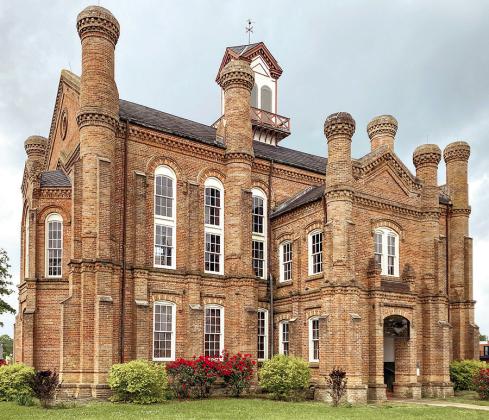The final report on the master plan for restoration of the 1885 Historic Shelby County Courthouse and grant application to fund it, dominated the Wednesday, April 17 meeting of the Shelby County Commissioners’ Court.
Jay Firsching of Texas-based historic preservation consulting firm HRTC Services presented it accompanied by Anne Stimmel of Architexas, a project partner.
Firsching said major issues were accessibility analysis, code analysis, and related items required while maintaining originality. He said the intent is to make the courthouse look like a building from the 1880s, but operate like a building with modern infrastructure.
Firsching termed the courthouse unusual, designed to only house part of the county offices, not the entire county government. “(Shelby County has) always … operated out of a campus of buildings rather than one central building,” he said.
“My fun, nerdy fact …,” said Firsching, “it’s the first public building (of that age) I’ve encountered with public restrooms inside.” Firsching said nobody he knew in historic restoration had heard of a building “this age” with inside restrooms.
According said the exterior and portions of the interior were remodeled in 19992000. Intentions now would be completing the restoration and redoing previous work to modern standards.
Firsching termed the building’s geothermal heating and cooling system as excellent but a maintenance problem. Plans include a new “easier and cheaper to main- tain system.”
Firsching noted a previous project inadvertently led to courthouse damage. “In 1916, cars (becoming popular), but there were still horses and wagons. They (improved) the square … created parking for both wagons and cars.” Doing that, Firsching said they raised the level of the square 16 to 24 inches making it flat but covering ventilation openings in the building’s crawl space, causing floor structure rotting. He said the 1999 restoration repaired rotting and added a drainage system that has not been successful.
“The moisture problem still persists,” said Firsching. “If we don’t do something, it’s probably gonna cause catastrophic problems in the future.”
“What the historical commission wants to see is … what could be done to make the building function as a county-used building,” Firsching said.
HRTC’s plans would locate some county offices on the first floor, with the upstairs courtroom used for commissioners’ court. Firsching said that “raises safety concerns.” Stairs in one side of the courtroom make it almost impossible to evacuate if a fire occurred at the end with stairs.
“We see no other real workable option other than to put a fire stair on the exterior of the building.” That would be in addition to a fire alarm detection system and sprinkler systems.
Firsching also reported the old jail was studied, but plans call for just code improvements, systems improvements and necessary repairs.
A budget prepared by Archer Construction in Paris, specialists in historic preservation, architecture, and construction, put the suggested courthouse work at about $7 million.
“That would give you a completely redone building with all new infrastructure and functionality,” Firsching said. That would comply with Texas Historical Commission requirements, according to Firsching, and “a $1 million county investment could get $7 million of work done.”
Firsching said the grant would cover the building itself, but not site work and other items. However, money spent (on those items) does count toward the match.
Teddy Hopkins and Rayford Copeland of the Shelby County Historical Commission updated work the SCHS has done to prepare for grant applications.
Hopkins addressed the importance of work considered and its value referring to historical events contemporaneous to the building of the historical Shelby County courthouse, such as the delivery and construction of the Statue of Liberty. He also mentioned downtown buildings built in the 19th century including the Payne building and the building that houses Toledo Finance.
Hopkins also noted the historic courthouse is well-known outside the county with a picture of it hanging in the Texas Supreme Court building entrance.
“So, there’s just too much history and historical value not to in- vest in this old building,” he concluded.
Copeland said two grants will be applied for. One, the restoration grant —an 85% to 15% match from the county.”
Copeland said the commission has looked at going back to the 1886 time period, when the courthouse was built and woodwork was stained. During the ‘99 restoration, it was painted brown. Restoration plans call for stained wood for the original look.
Copeland said the second planning grant 70% from the state and 30% from the county. Copeland requested approval for Architexas to assist in the grant application process, based on their experience.
Stimmel outlined the extensive experience her firm has with historic courthouse restorations, including Hill County following a fire. Architexas has worked with over 30 counties, doing 24 full restorations.
“They will do the application for a fee (about $3,000),” Copeland said. “But the Friends of the Shelby County Historical Commission would be willing to pay that fee.”
Copeland ended pointing out that the historic courthouse is the most well-known symbol of the county. “And it’s important for us to keep that,” he said.
After discussion, the court approved making the grant application for the restoration project.

